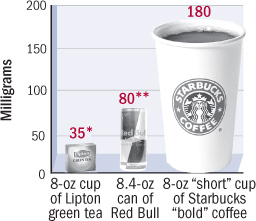
*35 mg presumes a single tea bag steeped in 8-ounce cup
**Per 8.4-ounce can
###
Full Citation: "Association of Coffee and Caffeine Consumption with Fatty Liver Disease, Non-alcoholic Steatohepatitis, and Degree of Hepatic Fibrosis." Jeffrey W Molloy, Christopher J Calcagno, Christopher D Williams, Frances J Jones, Dawn M Torres, Stephen A Harrison. Hepatology; December 22, 2011 (DOI: 10.1002/hep.24731); Print Issue Date: February 2012. http://onlinelibrary.wiley.com/doi/10.1002/hep.24731/abstract.| Coffee: A disease-by-disease report card | |
| Alzheimer's disease | Human and animal studies show hints of protection. Some preliminary evidence suggests activity against beta-amyloid plaque that may have a causative role in Alzheimer's. |
| Cancer | Studies suggest a lower risk for some cancers (endometrial, aggressive prostate, estrogen-negative breast), but not others (esophageal). Antioxidant and anti-inflammatory substances could be responsible for possible anticancer activity. |
| Diabetes | Effects on insulin and blood sugar levels that would promote diabetes seem to be temporary. Regular use is associated with lower risk, and high intake (3–6 cups a day) seems to have a greater effect. Protection may come from increases in the hormone adiponectin and other factors that affect insulin and blood sugar levels. |
| Heart attack | Coffee drinking increases some factors (homocysteine) associated with higher risk. But moderate consumption (1–3 cups a day) has been linked to a small decrease in risk. The evidence for a possible protective effect is stronger for women. |
| Liver disease | Coffee drinking is associated with lower levels of enzymes that indicate liver damage and inflammation. Coffee may improve response to some treatments for hepatitis C. Findings suggest some protection against liver cancer. Cafestol and kahweol, substances found in unfiltered coffee, may be responsible for liver benefits. |
| Parkinson's disease | Studies show a moderate (25%) decrease in risk for coffee drinkers. The effect is less in women. Research has found evidence of activity in the part of the brain affected by Parkinson's. |
| Stroke | Moderate consumption (3–4 cups a day) is associated with lower risk. But chance of a stroke may increase immediately after intake, particularly among infrequent consumers. |
Caffeine content *35 mg presumes a single tea bag steeped in 8-ounce cup **Per 8.4-ounce can |
| 欢迎光临 肝胆相照论坛 (http://hbvhbv.info/forum/) | Powered by Discuz! X1.5 |